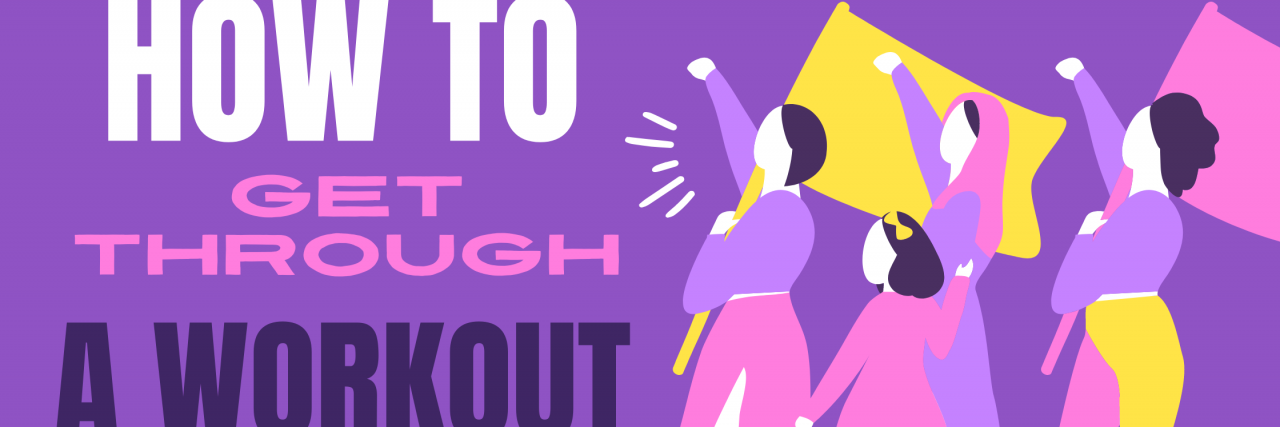We know exercise is good for us, but that doesn’t mean we always do it.
Physical activity helps with almost everything from mental health to cancer. Exercise can be a lot of different activities – as long as your heart rate is up, it counts! You want to build up to 150 minutes of exercise per week — about 30 minutes every workday.
• What is Ehlers-Danlos Syndrome?
• What Are Common Ehlers-Danlos Syndrome Symptoms?
Below are some tips to use during and after your exercise time.
During:
You can always build up as you feel confident but start slow.
- Don’t start with every day – it will likely be too much.
- Start with a short amount of time (maybe 30 minutes)
- Take on each exercise in a deliberate and controlled manner – focus on good form rather than speed.
- Don’t get up from a position/ machine too quickly, especially if you already struggle with vertigo or lightheadedness.
Start with the fun stuff.
- I personally hate cardio in pretty much every form. I start with strength training, get warmed up, and then I can take on the cardio part of my routine.
- You will likely find an exercise you are oddly good at. As chronic pain people, we are used to adapting to our pain by holding ourselves in weird ways. This likely strengthened some muscles you don’t even think about. For me, it is abs. My hips are my pain source of pain and my core has been forced to adapt to some of the ridiculous positions that I put myself in. I like to start with abs so I feel strong and powerful going into my other exercises.
Make deals to push yourself.
- Let’s say you want to hold a pose for 30 seconds. If you get to 10 seconds and you are really struggling, don’t give up.
- Make a deal with yourself – say “5 more seconds and then I can rest”.
- Then after a rest, finish the rest of your 30-second hold.
- You are still then able to complete the exercise and push yourself, but not strain or hurt yourself.
Maybe one of the hardest parts: Figure out what is normal hurt and what is bad hurt.
- This can be where someone like a personal trainer or physical therapist can be helpful.
- Unfortunately, this is sometimes where trial and error comes in, adjusting the weight and number of exercises so every repetition can be successful and have good form.
- Sometimes this means avoiding certain exercises and working out that muscle in a different way.
- For example, there is a rotating torso machine at our gym. No matter how strong I build my core, I always seem to strain my back when using this machine. I have found other ways to exercise my abs/obliques instead.
Track what you do.
- Let’s say your arms are super sore the next day. You can narrow down which exercises your arms were most used in and how to ease up on those particular exercises.
- It will also help you know what exercises to push harder on. If you focused on your legs, but they aren’t sore, you can choose to push those exercises harder next time.
- This will also help you see the progress and how much stronger you are getting.
Adapt as necessary within and between exercises.
- Within: Let’s say one of your exercises is to do mountain climbers. About halfway through, you are already straining. Instead of stopping entirely for the last half, adapt your exercise either to a “plank jack” (jumping jack on the ground) or an “up-down” plank.
- Between: If you complete two arm-focused exercises and are starting to strain, adapt your next exercises so they are not arms-focused, or just change the order of your movements to allow for your muscles to rest.
After:
Don’t skip the basics.
- Stretch, shower, eat some food and drink lots of water to replenish yourself!
- If electrolyte balance is an issue for you, you may want to drink a sports drink also.
Assess where you stand.
- If you enjoyed it: Remember and treasure that feeling! Use it on days when you are a little less motivated. Maybe even use this to improve other health or self-care areas.
- If you feel “Meh”: Reward your progress. That might tip the scales toward enjoying it. Also look for other ways to make it more enjoyable — different activities, different environments, etc.
- If you hated it: That’s OK. Why did you hate it? Were you bored? Did it hurt? Did you try to do too much? Once you identify what you are disliking, you can then identify what to change.
Just like with anything else we do in life, it might take a while to find the adaption that works for you. Give yourself some time to settle into the new addition to your routine; don’t reject it after just 1 or 2 tries. It’s just like medication — it often helps, but it takes some time to start working.
Remember, you don’t have to be motivated to complete an action. But it’s definitely easier if you enjoy it.
It can be hard to find a workout you enjoy, but hopefully, these tips will make your time a little more enjoyable.
This article is part of a series on Exercising With Chronic Illness. Read more here:
This story originally appeared on Paiges of Progress.

